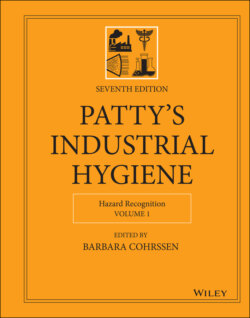Читать книгу Patty's Industrial Hygiene, Hazard Recognition - Группа авторов - Страница 82
5.4 Hazard Analysis and Risk Assessment Process
ОглавлениеAt the heart of PtD is the hazard analysis and risk assessment methodology. A comparison between Z590.3 model and the ISO 31000 risk management process model is represented in Figure 5.
The elements and steps in the hazard analysis and risk assessment process as outlined in Z590.3 are briefly described in the following:
Management direction. Management leadership and direction is essential throughout the process. Policy and expectations must be set for planned designs and the achievement of an ALOR. Policy elements include establishment of risk criteria, ALOR, and analysis parameters; implementation of a risk assessment process; risk treatment using the hierarchy of controls; risk acceptance decision‐making; and communication, documentation, and follow‐up.
Risk assessment matrix. A risk matrix provides a means of measuring and comparing risks by categorizing combinations of likelihood of occurrence and severity of harm. Matrices are useful in communicating risk levels and treatment options with decision‐makers. Risk assessment matrices or other validated processes should be customized to the organization's and stakeholders needs.
Analysis parameters. Parameters, purpose, and scope should be well‐defined upfront to include the system or task to be analyzed, its context, boundaries and limitations, operating phase, resources, and affected stakeholders.
Hazard identification. Trained risk assessors skilled in a systematic approach to identifying, assessing, and treating hazards are required in the process. Assessors should have an understanding of processes, technologies, tasks, and materials as well as actions or inactions that could result in exposure. In addition, assessors should identify potential synergistic effects of combined hazards and those hazards that are unseen, or potentially created in the process.
Failure modes. Failure modes resulting from circumstances including reasonably foreseeable uses and misuses of facilities, materials, and equipment that cause hazardous situations should be taken into account. Existing controls should be evaluated for their effectiveness, reliability, and whether controls can be defeated or cause failures.
Severity analysis. An analysis of “credible” worst‐case consequences defined by Z590.3 as those having “the potential to occur within the lifetime of the system” should be considered. Information on the severity of injuries and illnesses, property/equipment values, potential business interruption, environmental damage, or market share loss should be gathered from historical data, industry experience, best practices, and other sources.
Occurrence analysis. An estimate of the likelihood or probability of the exposure or event's occurrence should be determined. Occurrence analysis can include exposure frequency and duration, or dose–response and exposure assessments, and is generally related to a unit of time, an activity or event, number of units produced, or life cycle of a system.
Initial risk. The initial risk including existing controls is evaluated using the risk criteria and matrix selected to determine if it is acceptable or in need of further risk reduction.
Risk reduction and control methods. For risk levels that exceed acceptability, further risk reduction measures using the hierarchy of controls are selected.
Residual risk. A second assessment considering the new risk reduction measures is made to determine the remaining risk or “residual risk.” For risk levels that remain unacceptable, additional assessments and new risk treatments are applied until the risk is reduced to a level acceptable to the organization. If this cannot be achieved, the “high‐risk” operation shall not continue, except in unusual and emergency circumstances or as a closely monitored and limited exception circumstance with approval of the person having authority to accept the risk (11).
Risk acceptance. Using the organization's own defined “ALOR,” decision‐makers can determine if the risk is acceptable or if additional reduction is required. Higher risks may be tolerated temporarily by management in certain situations by using interim controls until more permanent measures can be fully implemented. This must be a risk‐based decision made by senior management.
Documentation. Information regarding the assessment, members involved, dates, methods, risks identified, treatments implemented to reduce risk, and other pertinent information should be documented and communicated to affected stakeholders and decision‐makers.
Follow up. Following implementation of control measures, an evaluation should be performed to determine their effectiveness and reliability, that no new hazards were inadvertently created, and that the risk level was adequately reduced. If the residual risk level is not acceptable, or if unintended consequences were created by the control measures, steps should be taken to reassess the risk and consider other risk treatment options.
Table 3 Listed methods from ISO 31010, ANSI Z590.3, and ANSI Z10.
